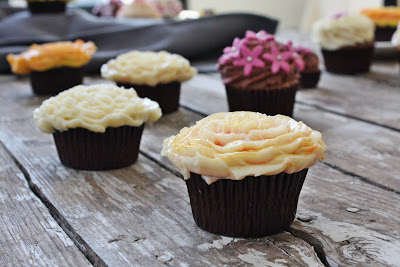On the south side of Seattle in a cavernous brewery-turned-loft-space, acclaimed photographer Lou Manna led a full day workshop on food photography. As we studied a series of images from Lou’s body of work, I worked feverishly, scrawling notes in the studio’s dim half-light. Less than an hour into his talk, I caved and purchased his book, “Digital Food Photography.”
Food photography is an enormous subject and you could easily spend a lifetime developing your craft. While most bloggers will never have a dedicated studio or six lights strategically aimed at tonight’s dinner, Lou touched on a number of points I’ll be incorporating:
- Study your camera’s manual. Whaddaya know? Understanding your camera’s features and how to use them properly, improves your photography. Lou takes his camera manual with him on trains, planes, and even to the potty. (Before this workshop, mine had never been out of the box!)
Control the Light
-Backlight or sidelight gives more dimension to your subject.
- Never, ever use direct flash.
- Slightly off-center composition is better. Remember the Rule of Thirds.
- Natural light is great but sun & shade turns photos flat. Outside, Lou shoots with a strobe 90% of the time and diffusion panels to soften the light.
- Do your photos have a blue cast to them? That’s from shooting natural light in the shade. Be aware of the blue cast. “Is the food blue?” No! Fix the white balance on your camera.
- Lamps cast a yellow tone to your photos.
- Custom white balance is best. Don’t know what that is? Read your manual.
- Light and the ability to control it is what makes a great shot.
Lou's Tips for Shooting Food
- Aim for a circular composition.
- Use a lightbox and a reflector.
- Use a small compact mirror or a reflector to bounce light and add detail back into the food. (Lou uses a portable mirror kit, made up of a variety of makeup mirrors. Especially helpful are mirrors with stands attached.)
- When using mirrors, know that they make a hard, controlled spot of light. (Example: To highlight the top of an appetizer, etc.)
- Use different sizes and shapes of food elements.
- Avoid having things line up perfectly (Think: Tangle of green beans vs. a stack of green beans. You want the tangle.)
- Simple composition is better. Make it clear. (Reviewing a photo of mushrooms sautéeing in a pan of butter. In the hot pan, butter is foaming excessively. Lou said, “What is this? I can’t tell. Use a pastry brush to remove some of the foam…The mushrooms will be more obvious.”)
- Remove any distracting elements in your composition. (Example: napkins in the background, extra glasses, question each piece of silverware, etc.)
- Keep it simple so the food is the star.
Two of my practice shots:
skip to main |
skip to sidebar

About Me

- Traca Savadogo
- What is a Tall Poppy? That's an Aussie expression for "a happy high achiever." I'm not so sure about the achiever part...but I do tend to find myself in some interesting situations. Come along with me! Want to get in touch? I'd love to hear from you! Contact: seattletallpoppy AT gmail DOT com
Media Mentions
"Traca is one of those natural born connectors with a genius for knowing the most interesting people and a hunger to introduce them to each other." - Michaele Weissman, author of God in a Cup
"Food guru" - Edible Seattle
"Seattle's matchmaker of food lovers." - Rebekah Denn, Seattle P.I.
"Food guru" - Edible Seattle
"Seattle's matchmaker of food lovers." - Rebekah Denn, Seattle P.I.
"A food voice to follow on Twitter." - Seattle Magazine
Posts of Note
Interviews & Rendezvous
- Alice Medrich, the First Lady of Chocolate
- Andrew Carmellini, author of the "Urban Italian"
- Authur Meyerson, photographer on The Color of Light
- Cindy Mushet, author of "The Art & Soul of Baking"
- Dianne Jacob, author of "Will Write for Food"
- Dr. Uwe Bratzler, Nuclear Particle Physicist at CERN
- Ivan Lo, documentary photographer
- Jason Wilson, chef/owner of Crush restaurant
- John Besh, chef, author, Iron Chef Winner
- Renee Behnke, author and Sur La Table president emeritus
- Sabrina Tinsley, chef/owner of LaSpiga & Iron Chef Challenger
- Shirley Corriher, food sleuth, author of "Cookwise" & "Bakewise"
Book Reviews
- Art & Soul of Baking
- Asian Dumplings
- Cookie Swap
- Falling Cloudberries: A World of Family Recipes
- Forking Fantastic
- Memorable Recipes: To Share with Family & Friends
- Simple Soirees: Seasonal Menus for Sensational Dinner Parties
- The Lighthouse Cookbook - Recipes from Heceta Head Lighthouse B&B
- Urban Italian
Project: Books That Paved the Way
I'm Reading:
Artisans
Authors
Books
Books That Paved the Way
Chefs
Cocktails
Design
Entertaining
Events
Fims
Hotels
Inspiration
International Food Blogger Conference
Interviews
James Beard Foundation
Media
Meet the Maker
Meet Your Farmer
Musings
Photographers
Recipes
Restaurants
Shopping
TEDx
Travel
Worlds of Flavor Conference







